Why getting the user experience right will protect your investment in tech and keep agents happy and productive. Caroline Handyside, Product Designer at Cirrus explains.
A product that is easy and intuitive to use, that guides contact centre agents through the myriad of different calls they make and take in a day, will help to keep employees motivated and engaged. This will enable customer service teams to deliver great customer experience (CX).
It is a truism that an organisation’s biggest investment (and liability) is its people. The difference between highly motivated and positively engaged employees compared to those that are disengaged or unengaged is huge and could be the difference between success and failure. The stakes are high.
Motivation makes the business successful
According to Gallup, disengaged employees have 37% higher absenteeism, 18% lower productivity and 15% lower profitability. When that translates into pounds sterling, you’re looking at the cost of 34% of a disengaged employee’s annual salary.
Put another way, highly engaged teams show 21% greater profitability, according to Gallup. Why? Those teams who score in the top 20% in engagement show a 41% reduction in absenteeism, and 59% less turnover. Engaged employees show up every day with passion, purpose, presence, and energy. (Source)
How to Keep your staff engaged and productive
Providing the right tools to do the job is a good start, but there’s more to it than a few nice looking screens, with this season’s colours, and the latest trendy widget. It is important that developers take a holistic view of the agent experience. They need to consider the system as a whole, how it works, how it delivers the exact piece of information agents need to their desktop. Then, how it pulls information from other systems, presents options so agents simply click the right one and can progress through to the completion of the task in hand benefits agents and customers alike.
For supervisors and managers look for Dashboards that provide an ‘at a glance’ status of their teams, number of calls waiting, average wait time, calls being escalated and agent adherence, so that it is easier to spot which agents may need support.
When you break it down, that’s a lot to process and the difference between User Experience and User Interface is important.
User Experience
User Experience (UX) is not about visuals, it focuses on the overall feel of the experience, and should use human-centred design principles. The UX design process deals with workflows and how the agent interacts with the software. It engages with the agent’s senses in a way that ensures they are not overwhelmed, which is particularly important during busy periods. A good design enables agents to perform tasks simultaneously, managing different workflows and multiple conversations across channels at the same time. Animation can bring the product to life and can be used to give reassurance to the agent that the system is responding, prompts ensure that nothing is forgotten and the agent can progress each call to a satisfactory conclusion.
Part of the design process is to test out multiple scenarios and customer journeys to ensure that they work in a real-life environment. By understanding and mapping user journeys through the product, investment can protected and the product future-proofed.
Vendors that work closely with customers when introducing new features will ensure that workflows are maintained and enhanced, and that they remain easy and intuitive for agents to use.
A well-designed user experience is based on flexible workflows that ensure an agent can do their job to the best of their ability.
User Interface
The user interface (UI) is the look and feel, the presentation and interactivity of a solution and brings everything together for the agent. UI design visually guides the agent through the system, making it intuitive to use so that they don’t need to think about it. UI elements should be placed with intent and the saying “less is more” is best practice. The ability for the end user to tailor what they see to suit their individual requirements is key. For example, presenting Dashboards that give instant updates on current stats, all definable by the end user. A Desktop which includes fast links to everything the agent needs during the course of their day. This could include pop-ups to display information held in different systems relevant to the call, access to shared in-boxes, webchat and links to PCI compliant payment solutions.
The design of the interface is important for agent efficiency, both in everyday use and for onboarding new agents. The design needs familiar elements to put the agent at ease, and to feel clean and clear (without undue screen clutter) for it to be intuitive to use. Attention to the look of the screen, use of certain colours and layouts, will also help to project a feeling of calm and efficiency for the agent.
Benefits of focusing on CX in the Contact Centre
Time saved leading to faster resolution times – the easier agents can access customer information and detail of previous conversations across all channels, the faster they can resolve the customer’s call
- More calls handled – faster resolution times mean that agents can take more calls during their day
- Better outcomes for customers – agents that can see previous conversations and interactions, can provide a better, more complete service to customers
- Agents feel more empowered and engaged – with access to more background information agents feel confident to act on their own initiative, which gives them a feeling of being in control and so more engaged
- Increased productivity – shorter resolution times, more calls taken, more enthusiastic agents, all adds up to big increases in productivity
- And therefore – More profit
A well-designed contact centre solution enables agents to work efficiently. Getting workflows right for agents makes their lives easier. It also helps to keep them engaged and motivated and protects the investment in technology. A well designed workflow-based solution that can overlay existing legacy systems means that new channels can be introduced easily to the customer contact infrastructure. The business can be confident that agents and the system can cope and customer satisfaction will soar.




